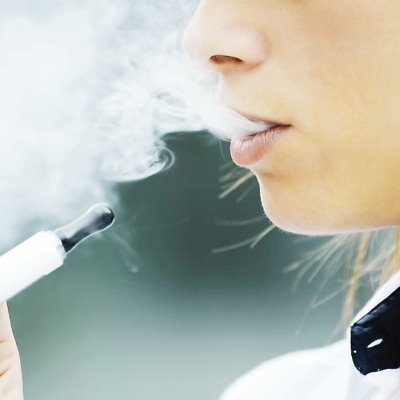click to dowload our latest edition
CLICK HERE TO SUBSCRIBE TO OUR NEWSLETTER


Published
5 years agoon
By
adminJORDAN MOSHE
The American-based Centers for Disease Control and Prevention (CDC) recently issued a warning on the dangers of vaping as more people are suffering from this mysterious lung condition. As the numbers rise, the fabled safety of vaping has been called into question, and health experts are urging users – especially youngsters – to stay away.
In the wake of a seventh reported death this week, New York state banned the sale of flavoured e-cigarettes, giving retailers two weeks to remove the merchandise from their shelves.
The vaping culture has gained increasing traction over the past few years, with a spike in popularity with the introduction of a variety of flavoured liquids and trendy handheld devices. An electronic cigarette or e-cigarette is a handheld battery-powered vaporiser that simulates smoking, including the hand-to-mouth action of smoking, not burning tobacco but nicotine. Using an e-cigarette is known as “vaping” and the user is referred to as a “vaper”.
It has had great appeal worldwide, and the problem is equally rife in South Africa, affecting the youth in particular.
“Young adults and teens think it’s fashionable,” says pulmonologist Dr Anton Meyberg. “The machines are sleek, they have an appeal, and they give off a good image. Youngsters see these attractive stands selling the products, and are drawn to it, believing it’s just a flavour and can’t do harm.”
Meyberg says vaping has also become popular with youngsters in the Jewish community, spurring schools to invite him to address pupils on the dangers of the seemingly innocuous habit. “School social workers are picking up on it, and want to address it,” he says. “We think it’s a developing pandemic amongst the youth.”
Daniel Sussman, Habonim secretary general and rosh machaneh, says that in his own experience, vaping is fairly commonplace amongst the youth by the age of 16. He says that by Grade 8, many children are already exposed to vaping.
“A big issue here is that parents place vaping in a separate class to other forms of smoking,” Sussman says. “It may be true that for a long-term smoker, some form of e-cigarette could be a healthier alternative. But, for a 15 or 16-year-old child with no tobacco addiction, we are no longer speaking about the lesser of two evils. Vaping is a gateway form of smoking as opposed to a pathway out of it.”
Meyberg says scholars are known to vape during break, sometimes even in class. A vape is easy to conceal. It’s often made to look like a USB flash drive or something like it which can be hidden easily. “You may not even be able to see the smoke coming out of it. That’s how difficult it may be to spot,” he says.
Vaping is particularly detrimental to young adults, Meyberg says, because their brains are more sensitive to nicotine as their uptake of nicotine is much higher. He says people who develop addictions tend to be young, and they often move on to cigarettes and marijuana.
“The central problem is that the habit affects behaviour, attention, mood, and impulse control,” he says. “There’s a lot of talk about what the vape contains, the chemicals being heated and inhaled. These cling to the lungs, and stop air from entering, affect the blood stream, and cause plenty of other internal damage. Still, youngsters see fashionable pictures marketing these things, and become lifelong users.”
He dismisses the often-peddled belief that the habit is harmless, saying that it’s worse, in fact, than smoking cigarettes. “People think it’s safe because it is marketed that way. The assurance that it’s safe doesn’t come from medical circles but from the vaping fraternity itself, which is a multibillion-dollar industry. There’s also the belief that it’s safer than smoking, but in young adults, it’s not. They experience other issues such as nicotine addiction, and could even end up smoking.”
The problem has been given much airspace in the media.
Meyberg says many deaths related to vaping have occurred in a short period of time, unlike smoking-related deaths. “We need time to understand what these things do to you, and it takes time for them to be studied,” he says. “This is why we see the surge suddenly. Studies – many of them by recognised medical journals – have begun, and are exposing the actual risks.”
“We are finding that younger people with respiratory illnesses are often those who vape. It’s common and getting worse.”
He says people are waking up and realising that the habit is dangerous, and more needs to be done to educate about the impact vaping has on one’s health. He believes we need to start at schools by engaging with children, even one on one, to explain what vaping actually does to one’s body.
“Rabbis, teachers, schools, and shuls need to be involved,” he says. “It’s an enormous and extremely profitable industry, and its products are being spread widely amongst the youth, so it’s going to be very difficult to dismantle. Still, we must educate people about the damage it does, and this is perhaps more necessary than ever before.
“Absolutely no good can come from exposing people to this substance,” he says. “It’s addictive. We need to strike while the iron is hot. I’m hoping that people will take note. Teens must not see vaping as cool, it’s not. It’s deadly.”

Devora Even-Tov
Sep 20, 2019 at 8:59 am
‘Hi. Should smoking the "nargila" as the youth are also so busy with also be a form of "vaping" and discouraged in the same way. I am convinced this carries the same risk and should be part of the discussion with the youth. Anyone agree with me?’